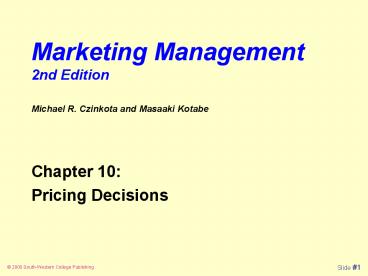Marketing Management 2nd Edition - PowerPoint PPT Presentation
1 / 20
Title:
Marketing Management 2nd Edition
Description:
Michael R. Czinkota and Masaaki Kotabe 2000 South-Western College Publishing. Slide #2 ... is seen as the most savage and destructive forms of business ... – PowerPoint PPT presentation
Number of Views:118
Avg rating:3.0/5.0
Title: Marketing Management 2nd Edition
1
Marketing Management2nd Edition
Michael R. Czinkota and Masaaki Kotabe
- Chapter 10
- Pricing Decisions
2
Importance of PriceProbably the single most
important marketing decision.
- Three variables that determine profit
-
X
Sales Volume
Price
Cost
Profit
3
Service Prices
- Differences in pricing for services
- Negotiation
- Variability leaves more room for negotiation
- Discounts
- Perishability leads to price incentives at
off-peak times - Quality
- Higher Pricing to signal Quality
4
Price for Non-Profit Organizations
- Surplus Allocation of service
- Queuing
- (e.g., organ transplant)
- Price is perceived value.
5
Supply and Demand
Supply curve
Equilibrium Price
Price
Demand curve
Quantity
6
Price Elasticity of DemandThe degree to which
demand is sensitive to price.
change in demand
Price elasticity of demand
change in price
7
Demand
- If an increase in price results in a decrease in
revenue, demand is elastic. Demand is sensitive
to price change. - P? leads to R ? demand is elastic
- If an increase in price results in an increase in
revenue, demand is inelastic. Demand is
insensitive to price change. - P? leads to R ? demand is inelastic
8
Three Ways to Estimate the Demand Curve
- Statistical analysis of historical data
- Problem Too many variables in normal complexity
of markets - Survey research
- Problem Results often inaccurate
- Experiment
- Can be successful.
- Problem Costs
9
Factors Affecting Demand ElasticityOrganization
Factors
- Product life cycle
- Stage in Life Cycle
- Skimming vs. Penetration
- Product portfolio
- Product line pricing
- Interrelated Demand (i.e., complementary or
alternatives) - Interrelated Costs (e.g., same facilities or
processes used) - Segmentation and positioning
- Can offer protection from pricing pressures.
- Branding
10
Factors Affecting Demand ElasticityCustomer
Factors
- Demand
- Benefits
- commodity price vs. premium price
- Value as perceived by the customer
- Distribution channel costs added
11
Factors Affecting Demand ElasticityMarket
Factors
- Competition
- Economic and regulatory environment
- Exchange rate
- Depreciation Making Imports more expensive and
Exports less expensive - Geography
- Uniform Pricing
- FOB (free on board) customer pays transport costs
- Zone Pricing
12
Pricing Strategies
Price Skimming Price HIGH
- Inelastic prices
- New or unique product
- Distinct market segments
- Quality important
- Competitive costs unknown
Penetration Pricing Price LOW
- Elastic prices
- Competitors can enter market
- No distinct market segments
- Products undifferentiated
- Economies of scale
13
Practical Pricing Policies
- Cost-plus pricing
- Target pricing (e.g., ROI)
- Historical pricing
- Product line pricing (e.g., price lining)
- Competitive pricing
- Market leader niche marketer in favored
position. - loss-leader pricing
- Market-based pricing (a.k.a., perceived value
pricing) - Price Positioning Where will brand be priced
relative to competition? - Quality Pricing (e.g., Rolls-Royce, Hilton
Hotels) - Budget Pricing
- Selective pricing
- Category Pricing
- Customer Group Pricing (e.g., students, seniors)
- Peak Pricing
- Yield Pricing (e.g., airlines)
- Service Level Pricing
14
Fundamental Errors in Setting Prices
- The tendency to think in terms of averages.
- The reluctance to let bygones be bygones (i.e.,
sunk costs). - The tendency to ignore alternatives (i.e.,
opportunity costs). - The tendency to emphasize cost considerations
over demand considerations (e.g., cost-plus
pricing).
15
Discounts
- Trade discounts
- Quantity discounts
- Cash discounts
- Allowances (e.g., trade-ins)
- Seasonal discounts
- Promotional pricing
- Individual pricing (i.e., haggling)
- Optional features (e.g., autos)
- Product bundling
- Value package
- Psychological pricing (e.g., recommended price,
9.99
11.99
9.99
16
Price Negotiation
- Sellers are in a strong position when
- Buyers each buy small quantities relative to the
total sales of the seller. - Buyers lack suitable alternative sources.
- Buyers face high switching costs.
- The cost of the item is a small part of the
buyers costs. - The cost of the product failing would be high.
- Cost savings resulting from use of the product
are significant. - Buyers have high quality images.
- Buyers want custom-designed products.
- Buyers organizations are highly profitable.
- The buyer is poorly informed.
- Large buyers are not necessarily the most price
conscious.
17
Price Wars
- Price competition is seen as the most savage and
destructive forms of business warfare. - The dangers of initiating a price war
- Low Quality Image
- Temporary Advantage
- Loss of Profit
- In some cases sales volume may make up for price
decrease. - Reasons to implement a price reduction
- Actual Cost Advantage
- Market Leadership Targeting
- Excess Capacity
- Falling Brand Share
18
Reactions to Price Challenges
- Reduce Price most popular reaction
- Maintain Price
- Split the Market
- Increase quality of main brand while launching a
fighting brand - React with Other Measures (e.g., improved quality
or increased promotion)
19
Price Increases
- Increase the price when everyone else does.
- Dont increase too much at any one time.
- Incremental increases (around the price of
inflation) are less noticeable. - Dont increase too often.
- Look after your key account (80/20).
- Provide sound and true - explanations.
20
Temporal Price Discrimination
- Time of day pricing
- Time when purchased
- Day of week pricing
- Seasonal pricing






![[PDF] Storey's Guide to Raising Meat Goats, 2nd Edition: Managing, Breeding, Marketing (Storey’s Guide to Raising) Kindle Edition Ipad PowerPoint PPT Presentation](https://s3.amazonaws.com/images.powershow.com/10100206.th0.jpg?_=20240816071)


![[PDF] Take Charge of Your Nursing Career: Open the Door to Your Dreams, Second Edition 2nd Edition Full PowerPoint PPT Presentation](https://s3.amazonaws.com/images.powershow.com/10102371.th0.jpg?_=20240820058)





















